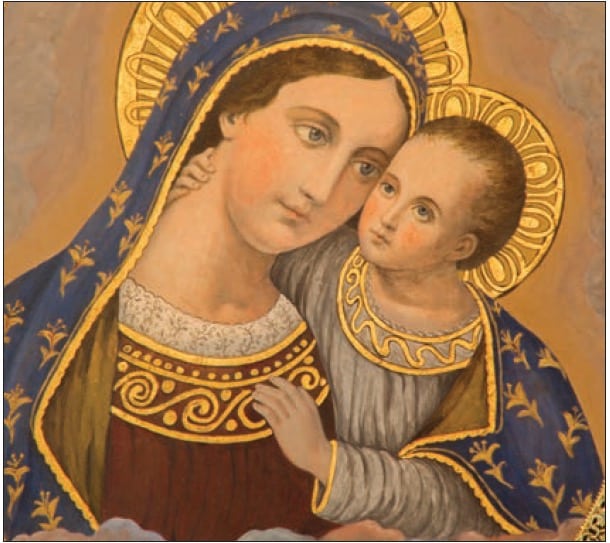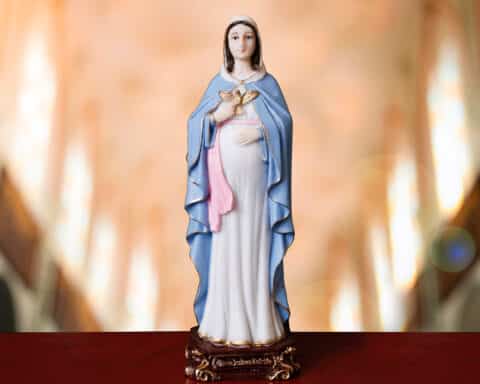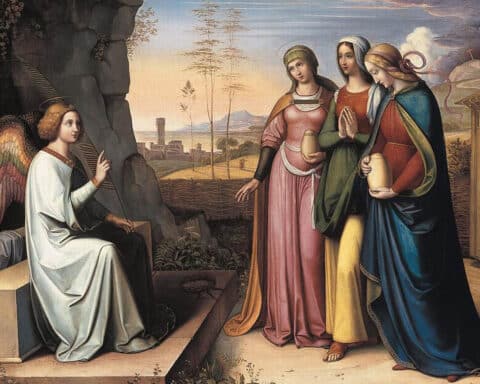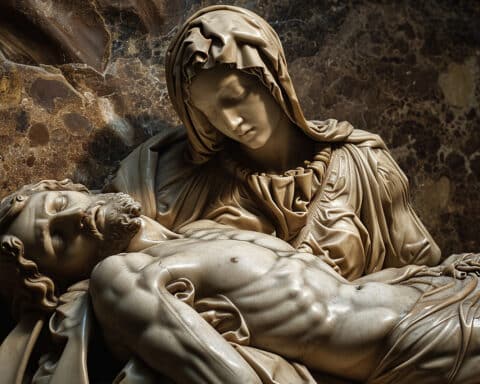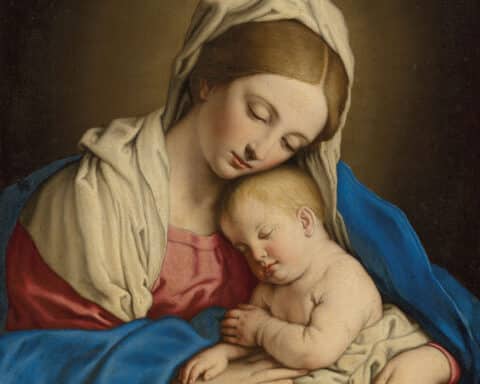The decision by Pope Francis to add the memorial of the Blessed Virgin Mary, Mother of the Church, to the universal liturgical calendar will, undoubtedly, prompt the publication of many commentaries and opinions, not to mention the thousands of homilies that will be preached all over the world when the memorial is celebrated on its given day, the Monday after Pentecost Sunday (May 21 this year).
Mary, of course, has never been slighted in terms of attention for as long as the Church has existed. One could state confidently that only her son has received more. But the kind of attention given to Mary has not always been healthy for the Church or the individual worshipper.
There are two extremes. One is to deny any place for Mary beyond being a vessel for the Savior; her participation was simply functional. The opposite extreme is to place so much significance on Mary’s role that she, in effect, is seen as a co-redeemer in an exaggerated sense with Jesus. Critics of this inflated view say that Mary’s (over)admirers want to make her the fourth person of the Trinity. How these extremes are manifested in the lives of believers range from non-engagement with Mary to a preoccupation with her that ignores even God himself.
‘Genuine Marian piety’
Into this maelstrom of opinions and pieties, Pope Francis has waded, perhaps in an effort to calm the waters. The decree that announced the universal celebration of the memorial states clearly the pope’s goal: to encourage among the faithful (clergy, religious, and laity) a growth in “genuine Marian piety.”
Of course, this begs the question: What is “genuine Marian piety?” The answer is not spelled out explicitly in the decree, but the decree does say where — and when — one should look to find an answer: the Second Vatican Council on Nov. 21, 1964.
| The New Marian Feast |
|---|
|
Memorial of the Blessed Virgin Mary, Mother of the Church – Mary was first called Mother of the Church by Blessed Pope Paul VI in 1964.
– A votive Mass with this title was created in 1975.
– In March, Pope Francis added the feast to the universal calendar of the Church.
– The feast is to be celebrated the Monday after Pentecost (May 21 this year).
|
On that date, Blessed Pope Paul VI did two things: He addressed the council at the end of its third session and he promulgated the dogmatic constitution Lumen Gentium, which ends with a chapter on Mary.
In the address, Paul VI declared that Mary should be invoked and honored as “Mother of the Church,” which was followed, in 1975, by the creation of a votive Mass in honor of Mary under the same title. This liturgy has now been made obligatory for the universal Church by Pope Francis.
In chapter 8 of Lumen Gentium, the reader finds an outline of Church teaching on the Blessed Virgin Mary. The content is not meant to offer a “complete doctrine” of Mary, nor is it meant to be the final word on matters concerning her. But it does lay out the boundaries for a “genuine Marian piety.”
Chapter 8 of Lumen Gentium is a masterwork of balance in its presentation of Mary and in its recommendation of the appropriate devotion due her. Indeed, the very fact that Mary’s role is discussed within a document about the Church is significant; some of the participants at the council wanted a separate document, but the majority argued that her distinction would not be lessened if it was displayed in its proper context: with her brothers and sisters. While Lumen Gentium distinguishes Mary as “endowed with the high office and dignity of being the Mother of the Son of God,” it also says that “she belongs to the offspring of Adam” and, therefore, “she is one with all those who are to be saved” (No. 53).
Grace-filled cooperator
To offer Mary appropriate devotion, one must be attentive to both her high office and her kinship with Adam. Emphasizing one attribute over the other, or ignoring one in favor of the other, misses the reality of Mary and leads to the two extremes already mentioned. It may also lead to an undervaluing of one’s own reality.
The truth about Mary concerns not only herself but also all humanity, and it is articulated in the Church’s doctrine of the Immaculate Conception: God chose a human being and enriched her with the gifts that enabled her to freely cooperate with him in his work of salvation (LG, No. 56). This means that Mary is “full of grace.” It means that, in cooperating with God, she models active faith and intercedes for the people of God: That is why she is called the Mother of the Church. Moreover, God’s gifts to Mary did not erase her freedom, but her constant “yes” to God fully realized his gifts.
If she, who received a unique holiness from God and kept it free from the stain of sin by his grace, was able to cooperate in the work of salvation, then the people of God who have received grace (Jn 1:16) through Mary’s child may do the same according to their own gifts and free consent.
The tragedy of missing the full reality of Mary is that the inherent dignity of every human being is devalued. If Mary is separate from humanity, then human beings cannot hope to imitate her. If she is merely a vessel that the deity used for his purpose, then free will and free cooperation with God are cheapened. One might even ask why God bothered to ask for Mary’s acceptance.
Lumen Gentium anticipated these problems and sought to nip them in the bud with two warnings: “… theologians and preachers of the divine word [are exhorted] to abstain zealously both from all gross exaggerations as well as from petty narrow-mindedness in considering the singular dignity of the Mother of God” (No. 67).
And the second: “Let the faithful remember moreover that true devotion consists neither in sterile or transitory affection, nor in a certain vain credulity, but proceeds from true faith, by which we are led to know the excellence of the Mother of God, and we are moved to a filial love toward our mother and to the imitation of her virtues” (No. 67).
Mother and sister
A “genuine Marian piety,” then, will involve imitating Mary and her many virtues, which include her own devotion to Jesus, her constant thankfulness to God for the gift of salvation, her prayerfulness, and her faithful questioning and obedience. But perhaps the most eminent among her great virtues is her use of God’s gift of freedom.
Mary is often venerated for her perpetual virginity and her obedience, as she should be. But these two virtues, as well as any other, were realized and fulfilled in freedom. As a human being, even gifted with God’s grace, Mary still had to make a choice. If she did not have the freedom to say “no,” if she never experienced temptation (as her son did), then she was not truly free.
Imagine her situation: a young woman asked to bear God’s son, her espoused set on divorcing her. Who knows what her neighbors said? How often did she have to bear the misunderstanding and even the hostility of others? Was she ever free of temptations and doubt? No one knows the exact details of her daily life, but Scripture does attest to her free cooperation with God. And because Mary did so, so can every human being.
There seems to be an attitude in the present culture that human beings must, at one point or another, yield to base instincts, to sin and to bad habits. Indeed, the overwhelming evidence seems to verify it. Human beings cannot soar to the mountaintop.
And yet we have Mary: our sister and our mother. To many people unfamiliar with her, she seems the epitome of ordinariness, and in fact she is ordinary in the best sense of the word. She led no nation; she amassed no fortune; she was unknown to the vast majority of her contemporaries. Yet she fulfilled her duties with love for God and neighbor. Greatness was not out of her reach because she chose to say “yes” to God. Mary yielded not to the limited visions of those around her, or those perhaps inside her mind that tempted her to choose another way, but instead she yielded to God and his grace. And that has made all the difference.
If we want to offer Mary appropriate devotion and to exercise genuine Marian piety, then like her we will use our freedom to imitate her and say “yes” to God.
David Werning writes from Virginia.

